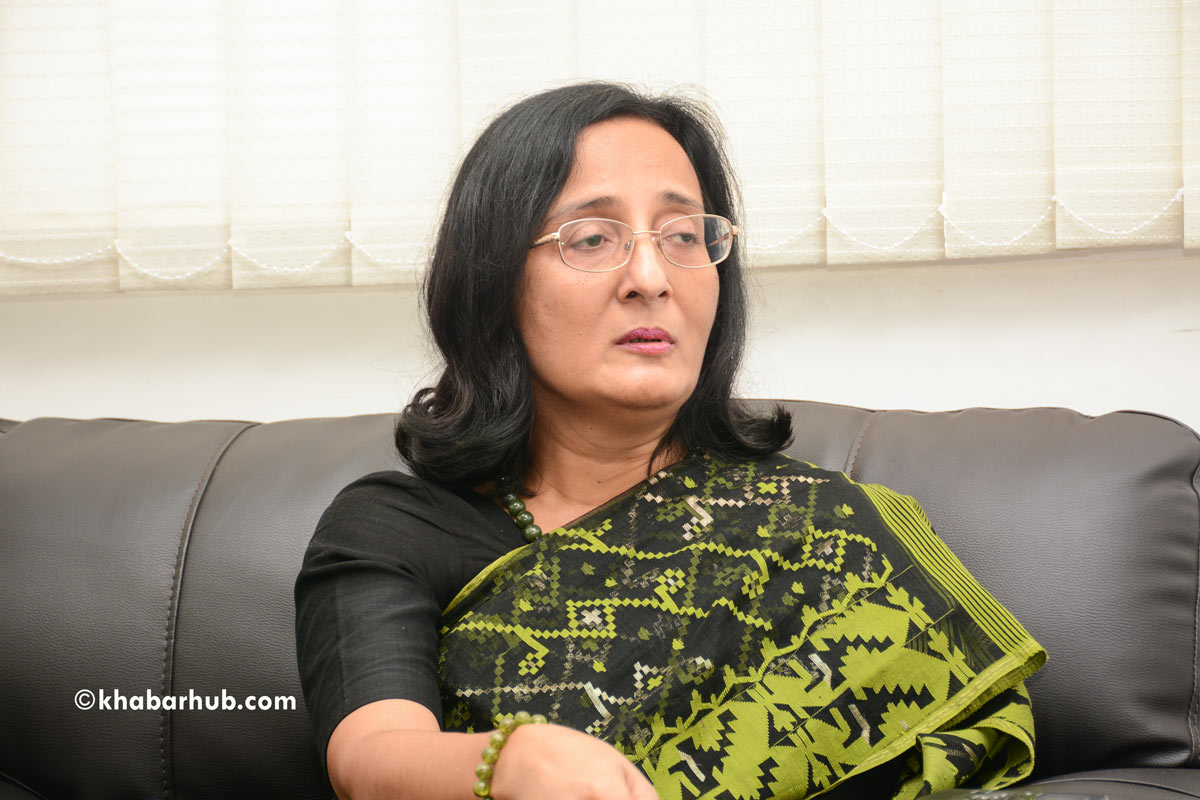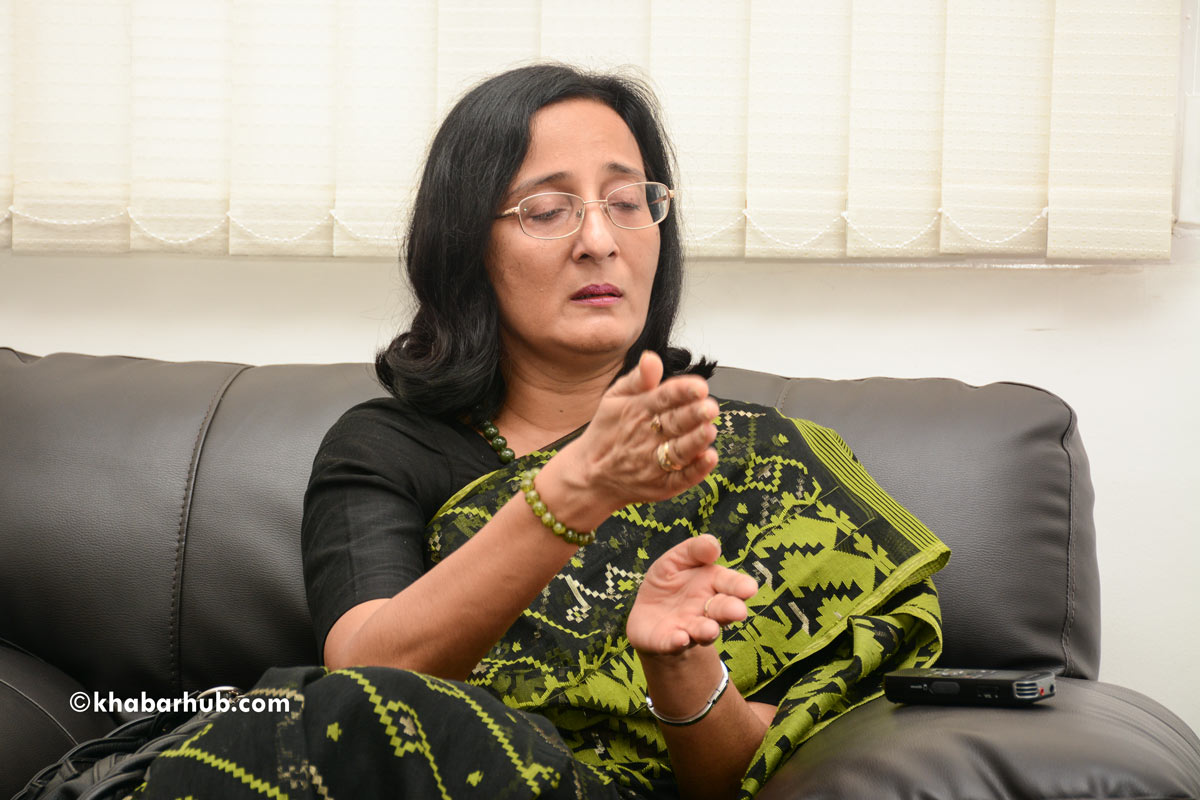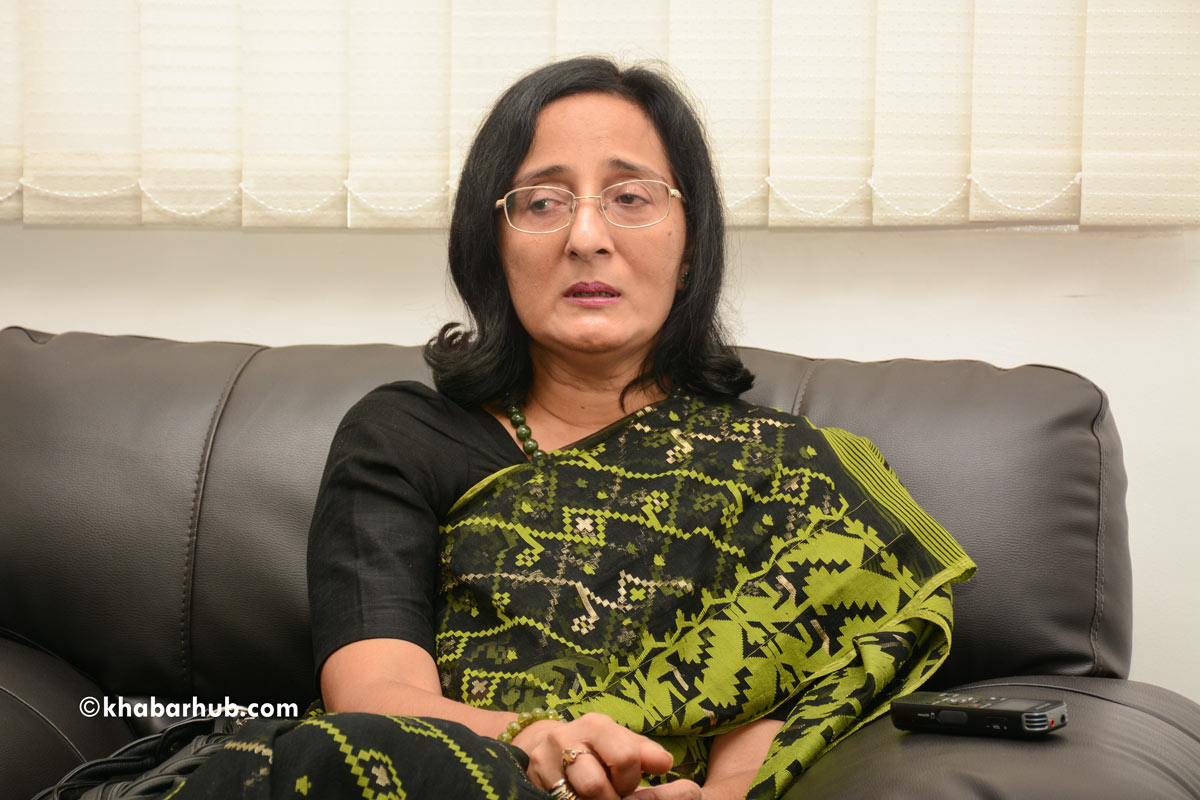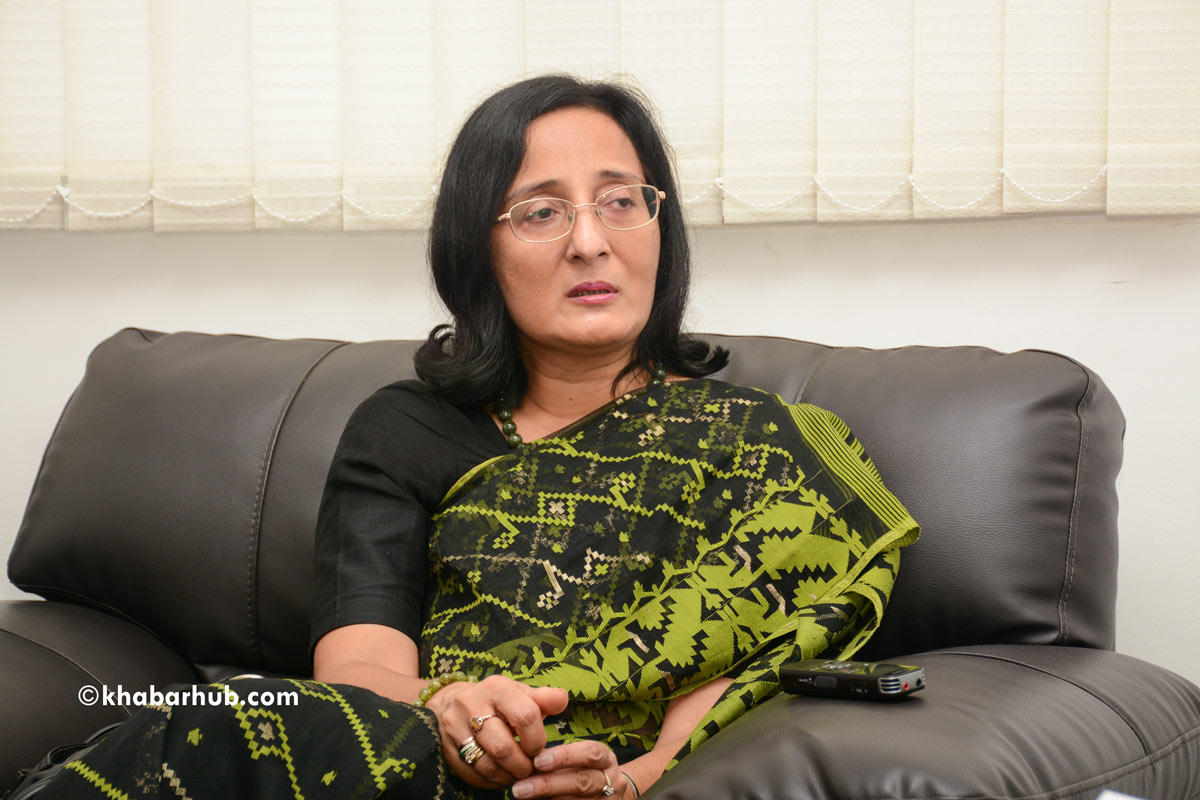Nepal export goods worth a billion-dollar to the world, out of which meager amount of goods worth 11 million dollars reach Bangladesh. This is negligible in the changed scenario of world trade when external trade – import and export has become so convenient and easy to do.
Nepal and Bangladesh share a relationship that goes back to centuries. There has been a good understanding between the leadership of both countries. As a fast-growing economy in the South Asian region, Bangladesh offers an opportunity for Nepali businessmen and tourists to reap economic benefits. Moreover, Bangladesh has a significant number of Nepali-origin Bangladeshi nationals who basically migrated to Bangladesh maybe some three to four generations ago for various reasons.
Nepal, too, can benefit from Bangladesh by exporting electricity. Against this backdrop, Ishwar Dev Khanal from Khabarhub talked with the Ambassador of Bangladesh to Nepal, Ms. Mashfee Binte Shams, on issues ranging from tourism, trade, business, and bilateral cooperation. Excerpts:

How do you assess Nepal-Bangladesh relations?
Relationship between Nepal and Bangladesh is really excellent one. Politically, we have a superb relationship. There is a good understanding between the highest leadership of the two countries. It’s, in fact, a relationship that goes back to centuries. And, Nepal has been our good friend during our war of liberation in 1971. Bangladesh has always appreciated this gesture and reciprocated whenever we get the opportunity. For example, Bangladesh tried to extend help during the devastating earthquake of Nepal in 2015 and at many such occasions.
You termed the relationship between Nepal and Bangladesh as an excellent one. What is your perception of ‘people to people contact’ between the two countries?
I think the people to people contact between the two countries is really strong, more than the political relationship. We have a significant number of Nepali students going to Bangladesh every year. More than 500 Nepali students visit Bangladesh every year for higher studies and their numbers are increasing every successive year. Apart from studying medical sciences, students from Nepal prefer to go to Bangladesh to study other streams such as engineering, pharmaceuticals, management, leather and textile technology, agriculture, among others. More interestingly, agriculture is a new subject attracting more numbers of Nepali students to enroll in Bangladeshi universities.
Nepal receives a large number of Bangladeshi tourists – more than 35 thousand every year. Bangladesh is a fast developing economy and in all likelihood, the number of Bangladeshi tourists will increase in Nepal in the near future. Bangladeshis have lately got fond of traveling abroad.
Being so close geographically, it takes an hour by air to reach Nepal from Bangladesh. Bangladeshis love to visit Nepal for seeing the Himalayas along with places of historical and cultural significance. I am hopeful that the number of Bangladeshi tourists in Nepal will double or be trebled in coming few years if promotional activities are undertaken in Bangladesh.

You hinted at the possibility of a significant increase in Bangladeshi tourists in Nepal especially when we are observing Visit Nepal 2020 next year. Can Nepal expect more Bangladeshi tourists to Nepal next year?
Definitely, you should expect so. However, as I said earlier, Nepal needs to carry out some promotional activities in Bangladesh. Maybe, as I feel, some sort of advertisements could be played on Bangladeshi TVs, or some sort of roadshows promoting Nepal tourism should be organized in Bangladesh. At present, most of the tourists visit Nepal from Bangladesh through on the basis of words-by-mouth without any active promotional campaigns so far.
Another thing that Nepal can do is to target the tourists coming by road as eastern Nepal is too close to northern Bangladesh. In fact, may Bangladeshi tourists go to Darjeeling (India) to see Mt Kanchenjunga as they do not know that they can also see it from Nepal’s Ilam.
Nepal could target the North Bangladeshis as their potential tourists as well. Moreover, a large number of tourists would have visited here if there was a direct bus service from Dhaka to Kathmandu (or direct road connectivity between the two countries). If Nepal can boost tourism in Ilam, Janakpur and Lumbini, it will really be highly beneficial for the country’s economy and will also ramp up the people-to-people contact between the two countries.
What is Bangladesh’s topmost priority in Nepal?
In fact, trade is a very important aspect of our mutually symbiotic relationship. Sadly though, trade is far below its actual potential. Right now, we are exporting the goods worth around 40 to 45 million dollars to Nepal and Nepal’s export to Bangladesh amounts to worth around 11 to 12 million dollars.
Comparing the value of exports from both the countries to each other, I think Nepal import very little from Bangladesh given the fact that Nepal imports the products of worth around 13 billion dollars from different parts of the world. It is a very negligible amount as Nepal can import more to Bangladesh.
Similarly, Nepal exports goods worth a billion-dollar to the world, out of which meager amount of goods worth 11 million dollars reach Bangladesh. This is negligible in the changed scenario of world trade when external trade – import and export has become so convenient and easy to do. All you have to do is to send a truck to Bangla Banda, load it and bring it back. I do not know exactly why people are not doing that.

What do you think what could be the reason people are not doing that?
One reason could be that the business communities of both countries are not very much aware of the potential they have in two countries. They want to concentrate on only their own domestic market. In fact, Bangladeshi businessmen think that Nepal is a very small market and they think that Nepali people would not be interested in Bangladeshi products. It is just an assumption, not a reality.
Do you think this assumption has been created due to lack of publicity by both the countries?
In fact, the Embassy of Bangladesh organized a Bangladesh Expo, a single country trade-fair in Kathmandu for last four years and we got a very good response from Nepalese traders, businessmen and common people of Nepal. However, some Bangladeshi big-value items such as motorcycles, furniture, electronics, food products, batteries, solar panels, construction materials, steel products have not reached the Nepalese market.
These products are actually on way to Nepal. Nepali people seem to be satisfied with the Bangladeshi products so far. Nepal used to export lentils to Bangladesh. However, Bangladesh now imports lentils form Canada at a much cheaper price.
And I have been trying to encourage Nepali exporters to export products such as Pashmina, ginger, or any other similar products because Bangladesh is a growing market now. I have come to know from some Nepali exporters that the process of exporting goods to Bangladesh is very complicated and lengthy.
Moreover, very high duty is imposed on the exported products (from other countries) by the Bangladeshi Government. But, I have always told them that the process is no different from other countries. As they export to different other countries, the same way they can export to Bangladesh also. If other countries can export to Bangladesh, why can’t Nepal?
Having said that, we Bangladeshis also want to encourage exports from Nepal. We are offering Nepal duty-free access for selected numbers of products. Nepal’s Ministry of Commerce is now studying the list of items. Hopefully, we can approve of the list mutually once it is cleared from the concerned ministry of Nepal. Hopefully, that would help to promote Nepali goods to Bangladesh.
In what areas can Bangladesh invest in Nepal?
Well, we are very much interested to import hydro-power from Nepal. The two countries signed an MoU in August 2018 for power sector cooperation. Bangladesh is an energy-hungry country and in the next couple of years, Nepal will be energy-surplus country.
So, Nepal can find a good market in Bangladesh and if necessary, Bangladesh can invest in the hydro-power sector here or we can buy it from Nepali hydro-electricity plants directly. Or, we can also go for equity sharing in producing hydroelectricity in Nepal. Bangladesh needs electricity. Even our minister has said so that Bangladesh can import roughly up to 9,000MW or even more from Nepal.
Apart from hydropower, are there any other areas that Bangladesh can invest in Nepal?
So far, Bangladesh has not made any big investments in any third country owing to some restrictions. There could still be an investment possibility in the tourism sector and in agro or food processing units.

What is the current status of BBIN (Bangladesh-Bhutan-India-Nepal) connectivity?
Actually, these countries signed a motor-vehicle agreement before. However, Bhutan has temporarily opted out. There was an initiative that the three countries (Bangladesh, India, and Nepal) could go ahead with the plan of road connectivity. There was even a trial bus run conducted from Dhaka to Kathmandu in April 2018. It was a success.
There was a lot of enthusiasm for the project. People were very hopeful that it could happen very quickly. However, somewhere down the line, it seemed to have got stuck in Nepal. For some reason, I think Nepal is not very sure what could be the benefits of this project of road connectivity.
But this agreement, I must clarify, is good for regional connectivity, integration, and trade. It is supposed to benefit the businesspersons of this region helping them in the transportation of goods and services and promoting tourism by enhancing people-to-people contact. It is not like a transit agreement.
For that, we have other mechanisms to follow and instruments to go by. This is only to promote inter-regional connectivity aimed at facilitating the movement of people from Dhaka to Kathmandu and from Kathmandu to New Delhi or from there to Dhaka and so on.
Initially, it will be only a bus service which will allow carriage of passengers and after it succeeds, it could graduate to cargo movement. People can have their own reservations on any new initiative such as this one. But that does not mean that we will not try to work out the problems to get a better way out.
You know, Nepal being a landlocked country can also ask or request for special consideration. And I am sure both India and Bangladesh will be happy to accommodate whatever concerns Nepal has raised about this project of road connectivity. If there are any concerns, Nepal can always talk to Bangladesh to sort them out. And I am sure there could be means and ways to accommodate Nepal’s concerns. Moreover, it is fun sometimes to travel by bus.
There is an ancient Buddhist traditional site in Pahadpur (Bangladesh) which was a Buddhist monastery and Vihar earlier dated to the 11th century. So, there is a very strong connection between Buddhism between the two countries. Bangladesh has also preserved Mahastanga, which dates back to the time of Emperor Ashoka.
During the course of excavation, which is going on presently, in Nepal’s Kapilvastu, a structure has been unearthed much similar to what was found in Mahastanga in the northern part of Bangladesh. There is a connection between the two countries dating back to some 2,000-2,500 years. Therefore, these places, such as Lumbini, Kapilvastu, Mahastanga, and Pahadpur, can be connected by bus to promote tourism and people-to-people contact.
By the way, what’s happening to SAARC now? Can it still be rejuvenated?
Initially, the idea behind SAARC was to bring or integrate the South-Asian nations by bringing socio-economic development in the region. It is, however, ironic that in SAARC, we are trying to integrate the region back but as it was before the British left.
The South Asian countries are not only going through socio-economic development but we are also going through political development. I am hopeful that, maybe, sometime in the near future, hopefully, the leadership will realize that it will benefit all of us. A strong SAARC or a strong South Asian region will benefit all the people of the region.
All the countries in the region are developing at a faster pace. We must all grow together. Maybe the socio-economic consideration will outgrow the political considerations and hopefully, we will be able to come together. But in the meantime, we are also working on BIMSTEC also. This is another way which can take the region forward.
And the best thing is that Bangladesh, Nepal, India, we have commonalities in SAARC and BIMSTEC. So, why don’t the three of us, including Bhutan, work together and create a strong hub from which the socio-economic development can spread to other countries in the region of South Asia.
A significant number of Bangladeshi nationals of Nepali-origin is in Bangladesh. Could you briefly tell us something about them?
Indeed, Bangladesh has a significant number of Nepali-origin Bangladeshi nationals. The number could be around 150,000, who basically migrated to Bangladesh maybe some three to four generations ago for various reasons. They are happily living there.
And especially in the Chittagong hill tracks (south-eastern Bangladesh), some Gurkhas were taken there during the British period for the management of the area. And even now in Rangamati, the district capital, there are around 300 Gurkha families there. And in the present cabinet of Prime Minister Sheikh Hasina, there is a State Minister for Chittagong Hill Tracks, Bir Bahadur who is a Nepali origin Bangladeshi citizen. We have a very strong centuries-old relationship. They are in business, in government service, and even in politics.








Comment